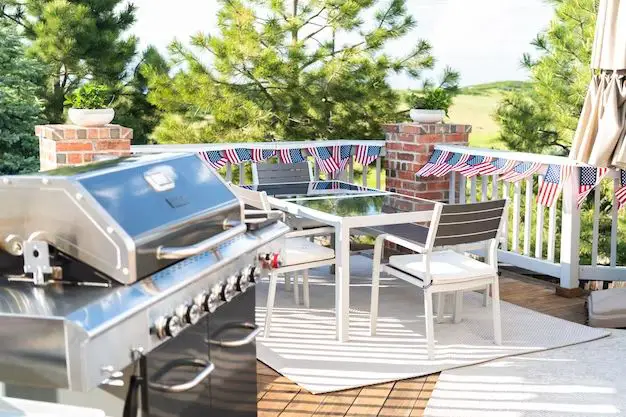Grilling under a covered patio is a common practice for many homeowners. It allows you to grill outdoors while still being protected from the elements. However, there are some safety considerations to keep in mind when grilling under a covered patio or other roof overhang.
Page Contents
Fire Safety Concerns
One of the biggest concerns with grilling under a covered patio is fire safety. Grills produce a lot of smoke and heat that can build up in a confined space. If the area is not properly ventilated, this increases the risks of fire and smoke inhalation. Here are some key factors to consider:
- Proximity to combustible materials – Grills should be placed away from siding, outdoor furniture, deck railings and any other flammable items. The greater the distance, the better.
- Overhead clearance – Look up and ensure there is adequate clearance between the grill and roof overhang. At least 3 feet is recommended by safety experts.
- Ventilation – Enclosed patios need proper ventilation to allow smoke, carbon monoxide and other byproducts to dissipate. Open doors/windows or install roof vents.
- Fire extinguisher – Always keep an ABC type fire extinguisher easily accessible when grilling in any enclosed area.
Other Safety Tips
In addition to fire risks, there are some other safety considerations when grilling under a covered patio:
- Trim overhangs – Trim back any tree branches or shrubs near the grill to prevent accidental ignition.
- Secure propane tanks – If using propane, make sure tanks are not near the grill and are securely fastened in place.
- Inspect for leaks – Check propane connections and hoses for leaks/damage before each use.
- Monitor conditions – Be aware of weather changes like wind that may impact ventilation.
- Don’t leave unattended – Stay near the grill at all times to monitor the fire and smoke.
Grill Placement
Where you place the grill under your covered patio or pergola is also very important:
- Away from entryways – Grills should be at least 10 feet away from doors, walkways or other access points.
- Avoid underneath beams – Do not grill directly under roof beams or other structural elements.
- On a non-combustible surface – Only grill on concrete, stone, brick or other fireproof materials.
- Away from exterior walls – Keep grills at least 2 feet away from siding, walls or banisters.
- Mind wind direction – Consider which direction smoke may blow based on prevailing winds.
Types of Grills
The type of grill you use under a covered patio can also impact safety:
| Grill Type | Safety Considerations |
|---|---|
| Propane |
|
| Charcoal |
|
| Electric |
|
| Natural Gas |
|
Ventilation Recommendations
Proper ventilation cannot be overstated when grilling in an enclosed area. Here are some recommended ways to ensure adequate air flow and ventilation:
- Open patio doors and windows – This allows air to naturally move through the area.
- Use roof vents – Vents and exhaust fans help pull smoke and heat upward and out.
- Install ceiling fans – Fans improve air circulation and also push heat upward.
- Remove sections of siding – Taking off pieces of siding improves exterior ventilation.
- Add a chimney starter – Allows smoke to easily exhaust.
- Use screened openings – Open areas with screens keep insects out while permitting airflow.
For larger covered patios, installation of permanent exhaust fans may be warranted. Consulting local building codes is advisable.
Safety Checklist
Here is a summary checklist of key safety tips when grilling under any roof overhang or covered patio:
- Grill is placed away from combustibles and entryways
- Adequate overhead clearance from roof (3+ feet)
- Area is well-ventilated with doors, windows, vents
- ABC fire extinguisher is nearby
- All gas connections and lines are leak-free
- Grill is only used on a non-combustible surface
- Grill is not left unattended when in use
- All tripping hazards like cords are removed
Conclusion
Grilling under a covered patio is fine if proper safety precautions are taken. Ensure there is adequate ventilation, all grills are a safe distance from combustibles, a fire extinguisher is on hand and you monitor the grill at all times. Consult your local fire department if you have any doubts or concerns. With the right setup and caution, you can safely enjoy outdoor grilling even under covered spaces.
